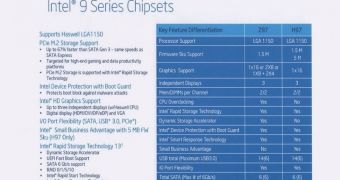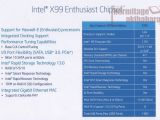Intel may not have released the 9-Series of chipsets yet, but all the relevant information about them has made it to the Internet anyway. And so we can now provide you with the details about the Z97 Express and H97 Express, plus the X99. All three will debut in the third or fourth quarter of 2014.
Even though the Haswell central processing units integrated many of the things the chipset used to handle, like the memory, there is still plenty that the motherboard logic has to manage.
For one thing, the Z97 and H97 have six SATA 6.0 Gbps ports each (with AHCI and RAID support), Intel Rapid Storage Technology, and Intel Smart Response Technology (SSD caching).
8-Lane PCI Express generation 2.0 root complex is available on both chips as well, plus six USB 3.0 and eight USB 2.0 ports.
Moreover, Z97 will also benefit from a Dynamic Storage Accelerator, but will lack Small Business Advantage (SBA) that the H97 has.
What's more, the Z97 gets three PCI Express 3.0 slots (wired to the CPU) in configurations of x16/NC/NC, x8/x8/NC, and x8/x4/x4.
Overclocking is supported as well, unlike on the H97. The H97 doesn't have the PCIe configurations either.
Finally, the Z97 and H97 chipsets bring support for PCI Express M.2 storage, which possess 66.6% higher bandwidth than SATA III 6.0 Gbps. That's the same as SATA-Express.
Thus, in addition to future central processing units, the two 9-Series chipsets will support the high-performance SSDs set to be launched later this year and in 2015.
Speaking of CPU support, the chipsets handle not only the Haswell line, but also the “Haswell refresh” and the “Devil's Canyon.”
The third chipset that Intel is preparing is called X99 Express and is intended for Haswell_E HEDT CPUs, designed with the LGA 2011-3 socket, which is not compatible with LGA 2011.
A 10-port SATA III 6.0 Gbps controller is part of it, along with an 8-lane PCI-Express gen 2.0 root complex (to drive on-board devices), the same 14-port USB controller as on the other two, and support for five PCI Express 3.0 x16 slots wired to the CPU.
The PCIe slots can be configured in x16/NC/x16/NC/x8, or x16/NC/x8/x8/x8, or even x8/x8/x8/x8/x8. It means that you can set up a powerful multi-GPU configuration and install a PCIe SSD like the OCZ Z-Drive 4500 (3.2 TB, 2,900 MB/s speed).
At this point, all that is left is to keep a lookout for a more specific ETA (estimated time of arrival) than Q3-Q4.

 14 DAY TRIAL //
14 DAY TRIAL // 
